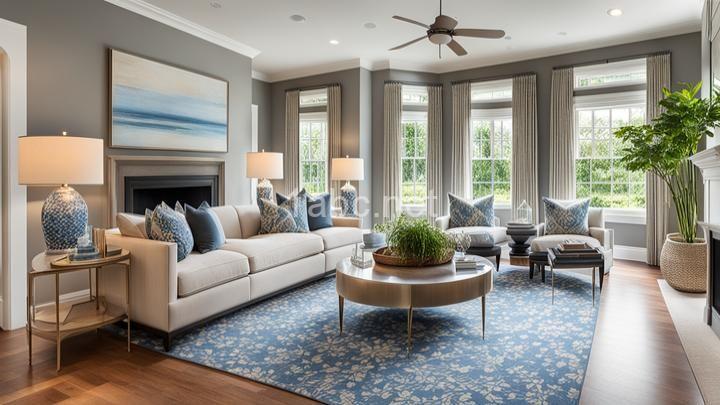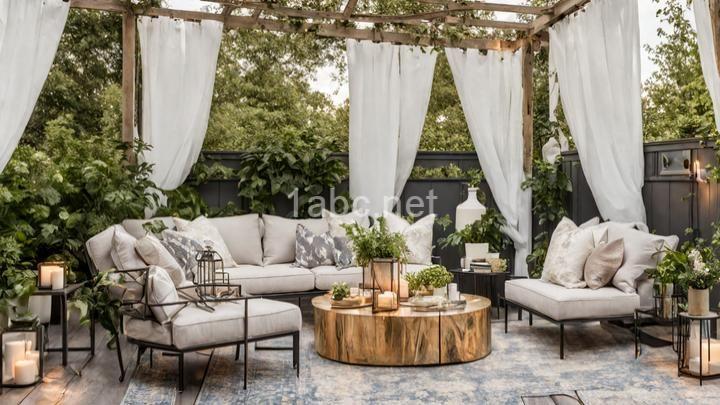Staging to Sell: How to Make a Lasting Impression on Potential Buyers

Introduction:
Welcome, dear readers! Today, we are going to embark on a friendly and helpful discussion about staging homes to sell. Selling a home can be a daunting task, but with the right strategies and techniques, you can make a lasting impression on potential buyers that will maximize your selling opportunities. In this blog post, we will outline the key points that will guide you through the process of staging your home to perfection.
I. Understanding the Power of Staging:
To kick things off, let's define what home staging actually is and why it is crucial in today's competitive real estate market. Home staging is the art of preparing and presenting your home in a way that appeals to potential buyers. When done effectively, staging can have a significant impact on the selling outcome. It not only increases buyer interest but also leads to faster sales and potentially higher offers. In fact, studies have shown that staged homes tend to sell faster and for a higher price than non-staged homes.
Imagine this scenario: Two identical houses are on the market, side by side. One is staged to perfection, with tasteful furniture, neutral colors, and strategically placed accessories. The other is cluttered, with personal items scattered throughout and an outdated color scheme. Which house do you think potential buyers would be more drawn to? You guessed it - the staged one! Staging creates an emotional connection with buyers and allows them to envision themselves living in the space. It helps them see the true potential of the home and increases their desire to make an offer.
II. Preparing Your Home for Staging:
Now that we understand the power of staging, let's dive into the steps you can take to prepare your home for this transformation. The first and most important step is decluttering and organizing each room. It's time to bid farewell to the excess items that have accumulated over the years. Remember, less is more when it comes to staging. Potential buyers want to see a clean and spacious environment that allows them to imagine their own belongings in the space. So, start by removing personal items such as family photos and knick-knacks. Rearrange furniture to create an open and inviting flow, and don't forget to maximize natural light by opening curtains and blinds.
III. Enhancing Curb Appeal:
They say first impressions matter, and that couldn't be truer when it comes to selling your home. Curb appeal plays a significant role in attracting potential buyers from the moment they see your home's exterior. So, let's spruce things up a bit, shall we? Start by maintaining the landscaping. Trim the hedges, mow the lawn, and plant some colorful flowers to add a pop of vibrancy. A fresh coat of paint on the front door or trim can work wonders in giving your home a welcoming and polished look. Consider adding some potted plants or outdoor seating areas to create an inviting atmosphere.
IV. Creating Inviting Interiors:
Now that we've tackled the exterior, let's focus on the interiors. Creating inviting spaces is essential in making potential buyers feel welcome and comfortable. One of the key aspects to consider here is color choice. Neutral colors are your best friend when it comes to staging. They create a blank canvas that allows potential buyers to imagine their own style and preferences in the space. Additionally, pay attention to furniture arrangement. Create conversation areas that invite people to sit and relax. And of course, accessorizing is key. Add some tasteful and strategically placed accessories such as artwork, throw pillows, or fresh flowers to enhance the overall ambiance.
V. Showcasing Key Features:
Every home has its unique selling points or standout features. It's important to draw attention to these features and make them shine. Whether it's a stunning architectural detail, a breathtaking view, or a specific amenity, strategic placement of furniture or accessories can highlight these attributes. For example, if you have a beautiful fireplace, arrange the furniture in a way that draws attention to it. If your home boasts a spacious kitchen, showcase it by keeping the countertops clutter-free and adding some inviting elements like a bowl of fresh fruit or a cookbook on display. Make sure functional spaces like home offices, bonus rooms, or outdoor living areas are showcased to their full potential.
VI. Appeal to the Senses:
When it comes to showings or open houses, appealing to potential buyers' senses can make a big difference. Creating pleasant scents, playing soft background music, and ensuring a comfortable temperature can all contribute to a positive experience. Consider using candles or diffusers with subtle scents like lavender or vanilla to create a cozy atmosphere. Soft instrumental music playing in the background can create a soothing and inviting vibe. Lastly, make sure the temperature is just right. You want potential buyers to feel comfortable and at ease as they explore your home.
Conclusion:
To wrap up, let's recap the main points we've discussed in this blog post. Staging your home is crucial in today's competitive real estate market. It increases buyer interest, leads to faster sales, and potentially higher offers. By following the steps we've outlined - from decluttering and organizing to enhancing curb appeal, creating inviting interiors, showcasing key features, and appealing to the senses - you can make a lasting impression on potential buyers. So, what are you waiting for? It's time to take action and start staging your home with confidence!
Closing Remark:
Thank you for taking the time to read our blog post. We hope you found it informative and helpful in your home-selling journey. If you have any further questions or need more resources, feel free to reach out to us. We are here to assist you every step of the way. Best of luck with your staging endeavors!
Warmest regards,
The dorenelashay9177 Team
FREQUENTLY ASKED QUESTIONS
Why is staging important when selling a home?
Staging is crucial when selling a home for several reasons. Firstly, it helps create a positive first impression for potential buyers. By showcasing the property in its best light, staging allows buyers to envision themselves living in the space. It helps them connect emotionally with the property, increasing their likelihood of making an offer.Secondly, staging helps highlight the home's key features and functionality. Professional stagers strategically arrange furniture, decor, and accessories to maximize space, improve flow, and accentuate the property's unique selling points. This not only enhances the overall appeal but also helps buyers understand how they can utilize the space effectively.
Furthermore, staging can help neutralize any personalized elements or design choices that may not align with potential buyers' tastes. By creating a more neutral and universally appealing atmosphere, staging allows buyers to imagine adding their personal touch to the home without being distracted by the seller's personal style.
Moreover, staged homes often photograph better, resulting in eye-catching online listings that attract more potential buyers. In today's digital age, the majority of homebuyers begin their search online, and high-quality photos can significantly impact their interest in a property.
Lastly, staging can potentially lead to a higher selling price and a faster sale. When a home is staged, it typically appears more inviting and well-maintained, which can increase its perceived value. Additionally, staged homes tend to spend less time on the market, reducing the chances of price reductions or becoming stale listings.
In conclusion, staging is important when selling a home because it helps create a positive first impression, showcases the property's key features, neutralizes personalized elements, improves online visibility, and can potentially result in a higher selling price and faster sale. By investing in staging, sellers can increase their chances of attracting more buyers and achieving a successful sale.
Can I stage my home myself or should I hire a professional?
When it comes to staging your home, you have two options: doing it yourself or hiring a professional. Both options have their pros and cons, so it really depends on your personal preferences and circumstances.If you have a knack for interior design and enjoy getting creative, staging your home yourself can be a fun and rewarding experience. It allows you to put your personal touch on each room and showcase your home in a way that reflects your style. DIY staging can also be a cost-effective option, as you won't have to pay for professional services.
However, it's important to keep in mind that staging a home requires a certain level of expertise. A professional stager has the knowledge and experience to highlight your home's best features and create a welcoming environment that appeals to potential buyers. They know how to arrange furniture, use lighting effectively, and create a cohesive flow throughout the house.
Another advantage of hiring a professional stager is their objectivity. They can view your home from a buyer's perspective and make unbiased recommendations on how to enhance its appeal. This can be particularly helpful if you're emotionally attached to your home and find it difficult to see its flaws.
Ultimately, the decision to stage your home yourself or hire a professional boils down to your budget, time constraints, and confidence in your own abilities. If you have the resources and feel overwhelmed by the process, it might be worth considering professional help. On the other hand, if you enjoy DIY projects and have the time to spare, staging your home yourself can be a rewarding endeavor.
Remember, the goal of staging is to create a welcoming and visually appealing space that potential buyers can envision themselves living in. Whether you choose to go the DIY route or enlist the help of a professional, the end result should be a home that stands out in the real estate market.
What are some common staging techniques?
Staging techniques are widely used in various fields, such as theater, interior design, and real estate, to create a visually appealing and harmonious environment. Here are some common staging techniques that can help transform a space:
-
Decluttering: Removing unnecessary items and organizing the space can instantly make it feel more open and inviting.
-
Furniture arrangement: Proper placement of furniture can enhance the flow and functionality of a room. Consider creating conversation areas or focal points to draw attention.
-
Lighting: Good lighting can greatly impact the ambiance of a space. Using a combination of natural and artificial lighting can create a warm and inviting atmosphere.
-
Color coordination: Choosing a cohesive color palette can tie the different elements of a space together. It's important to consider the mood and desired effect when selecting colors.
-
Accessorizing: Adding carefully selected accessories, such as artwork, cushions, or plants, can add character and personality to a room. Be mindful of proportion and balance.
-
Creating focal points: Highlighting a specific area or element can draw attention and create a focal point. This can be achieved through the use of accent walls, statement furniture pieces, or artwork.
-
Rearranging or adding decorative elements: Sometimes, a simple change in the placement of decor items or the addition of new pieces can breathe new life into a space. Experiment with different arrangements and styles to find what works best.
-
Incorporating textures: Combining different textures, such as smooth fabrics, rough wood, or shiny metals, can add depth and visual interest to a room.
-
Showcasing functionality: If staging a home, it's important to highlight the functionality of each space. Showcasing how different areas can be used can help potential buyers envision themselves living in the space.
Remember, staging is about creating an environment that appeals to a wide range of individuals. These techniques can be adapted to suit different needs and preferences, so don't be afraid to get creative and have fun with it!
How long does the staging process take?
The duration of the staging process can vary depending on several factors. On average, staging a property can take anywhere from a few days to a few weeks. It depends on the size of the property, the level of preparation needed, and the availability of the staging team. Additionally, the specific requirements and goals of the staging project can also impact the timeline. To get a better estimate, it is recommended to consult with a professional stager who can assess the specific needs of your property and provide a more accurate timeline.


